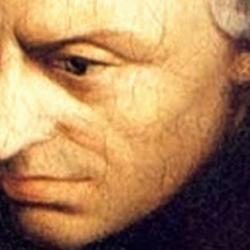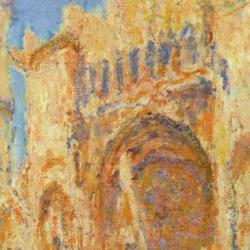Ruskin’s concept of “typical beauty” is a piece of theological aesthetics. In the second volume of Modern Painters, Ruskin distinguished kinds of beauty, the typical and the vital.
Of the first, he says: “that external quality of bodies already so often spoken of, and which, whether it occur in a stone, flower, beast, or man, is absolutely identical: which . . . may be shown to be in some sort typical of the Divine attributes, and which, therefore, I shall, for distinction’s sake, call Typical Beauty.”
Later he describes typical beauty in similar terms: Beauty “is either the record of conscience, written in things external, or it is a symbolizing of Divine attributes in matter, or it is the felicity of living things, or the perfect fulfilment of their duties and functions. In all cases it is something Divine; either the approving voice of God, the glorious symbol of Him, the evidence of His kind presence, or the obedience to His will by Him induced and supported.”
The second type of beauty is “the appearance of felicitous fulfilment of function in living things, more especially of the joyful and right exertion of perfect life in man; and this kind of beauty I shall call Vital Beauty.”
“Typical” is linked to the hermeneutical notion of a “type.” It suggests that beauty is found in those things that can be regarded as types of God’s attributes. Ruskin’s basic conceptions of beauty are thus derived from divine attributes:
1.Infinity: A type of divine incomprehensibility.
2. Unity: A type of divine comprehensiveness.
3. Repose: A type of divine permanence.
4. Symmetry: A type of divine justice.
5. Purity: A type of divine energy.
6. Moderation: A type of government by law.
A few illustrations of Ruskin’s reasoning will clarify. “Unity” functions not only as a divine attribute and principle of beauty but as a metaphysical conception. Unity doesn’t eliminate variety; unity depends on variety. Ruskin doesn’t approve variety for its own sake, but variety that perfects unity. Thus, in creation “there is not any matter, nor any spirit, nor any creature, but it is capable of a unity of some kind with other creatures; and in that unity is its perfection and theirs, and a pleasure also for the beholding of all other creatures that can behold.”
This “unity of spirits is partly in their sympathy, and partly in their giving and taking, and always in their love; and these are their delight and their strength; for their strength is in their co-working and army fellowship, and their delight is in the giving and receiving of alternate and perpetual good; their inseparable dependency on each other’s being, and their essential and perfect depending on their Creator’s.”
The unity that is truly beautiful is less the “the dead and cold peace of undisturbed stones and solitary mountains” than “the living peace of trust, and the living power of support; of hands that hold each other and are still.”
In this sense, created and artistic unity express what he describes as the “comprehensiveness” of God. God’s unity doesn’t consist “in his own singleness or separation, but in the necessity of his inherence in all things that be, without which no creature of any kind could hold existence for a moment.” This is better called comprehensiveness than “unity,” since “unity is often understood in the sense of oneness or singleness, instead of universality. The kind of unity is “that on which turned the last words and prayer of Christ before His crossing of the Kedron brook. ‘Neither pray I for these alone, but for them also which shall believe on Me through their word; that they all may be one, as Thou, Father, art in Me, and I in Thee.'”
Ruskin doesn’t make anything of the Trinitarian hint, but it’s there.
Ruskin devotes a great deal of attention to the distorting effects of emotion on art. Strong feeling can blind us to what is really there; we see the world as a mirror of our emotional states. He develops an aesthetic theory that acknowledges both the essential character and the danger of powerful emotion. “Repose” is therefore a high artistic value, one that he roots in the eternity of God:
“As opposed to passion, change, fitfulness, or laborious exertion, Repose is the especial and separating characteristic of the eternal mind and power. It is the ‘I am’ of the Creator opposed to the ‘I become’ of all creatures; it is the sign alike of the supreme knowledge which is incapable of surprise, the supreme power which is incapable of labour, the supreme volition which is incapable of change; it is the stillness of the beams of the eternal chambers, laid upon the variable waters of ministering creatures.”
This divine attribute is all the more attractive to human beings “through the infliction upon the fallen creature of a curse necessitating a labour, once unnatural, and still most painful.” Thus, “the desire of rest planted in the heart is no sensual nor unworthy one, but a longing for renovation, and for escape from a state whose every phase is mere preparation for another equally transitory, to one in which permanence shall have become possible through perfection. Hence the great call of Christ to men, that call on which St. Augustine fixed as the essential expression of Christian hope, is accompanied by the promise of rest; and the death-bequest of Christ to men is peace.”
As to “purity,” this cannot mean sinlessness “if it be indeed in the signs of Divine and not of human attributes that beauty consists.” Such an idea is “not in any way to be attached to His abstract nature: while the Love, Mercifulness, and Justice of God I have supposed to be symbolized by other qualities of beauty, and I cannot trace any rational connection between them and the idea of Spotlessness in matter.”
Rather, as an attribute of God purity means energy: “the only idea, which I think can be legitimately connected with purity of matter, is this of vital and energetic connection among its particles; as that of foulness is essentially connected with dissolution and death.” Artistically, he associates purity with light and color, which are desirable “because expressive of that constant presence and energising of the Deity by which all things live and move, and have their being; and that foulness is painful as the accompaniment of disorder and decay, and always indicative of the withdrawal of Divine support.”
Ruskin’s theory of typical beauty is, as George Landow notes, decidedly Apollonian. One might wish for a dose of the Dionysian. However we assess the specifics, one can admire the attempt to develop a theocentric and typological theory of beauty.










